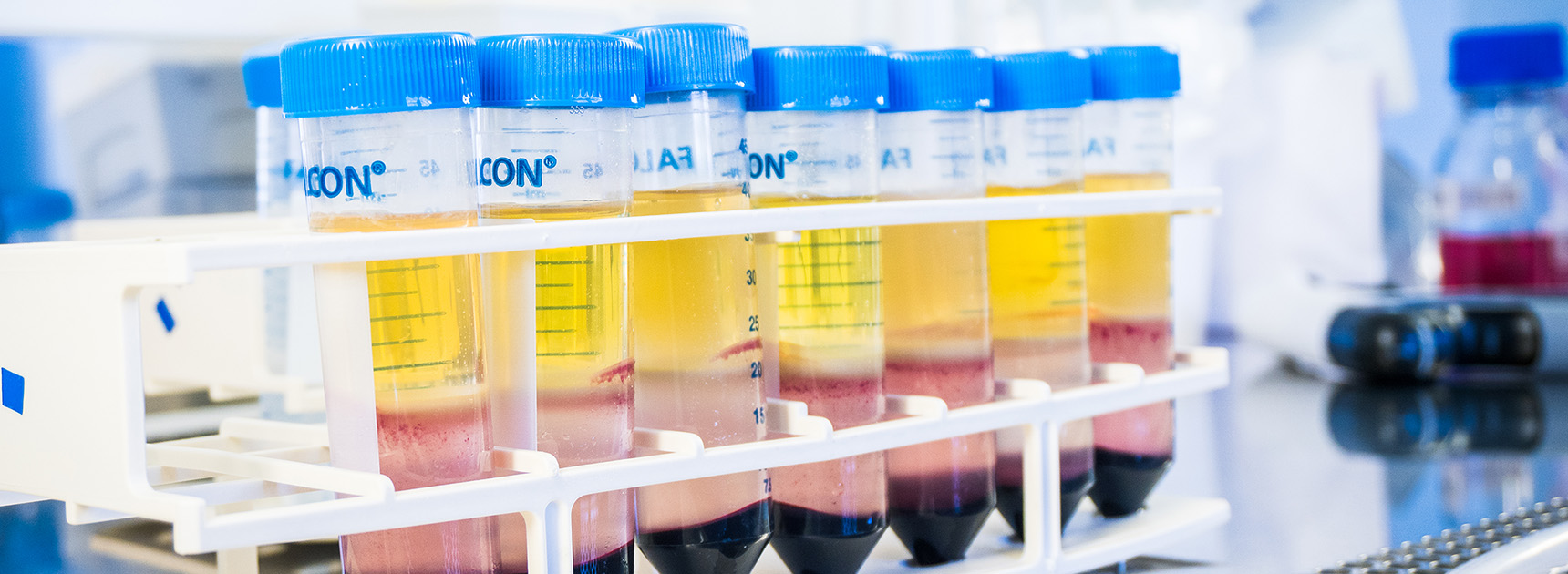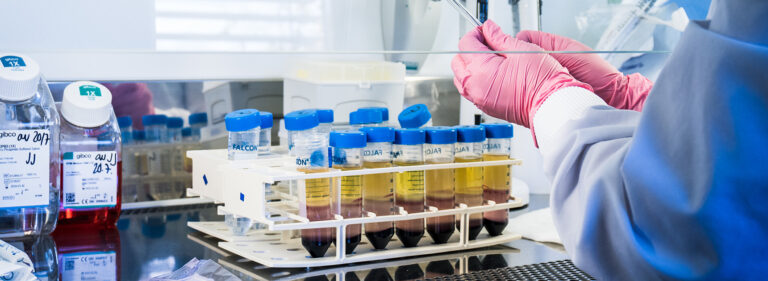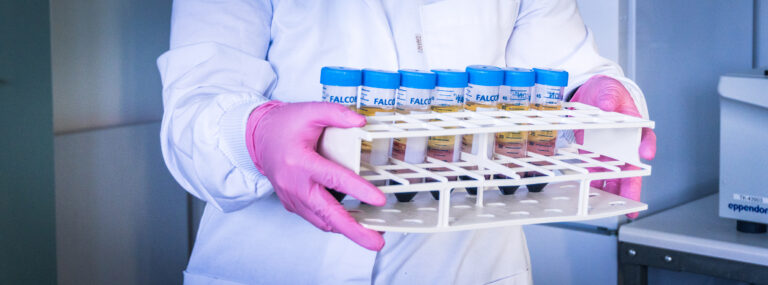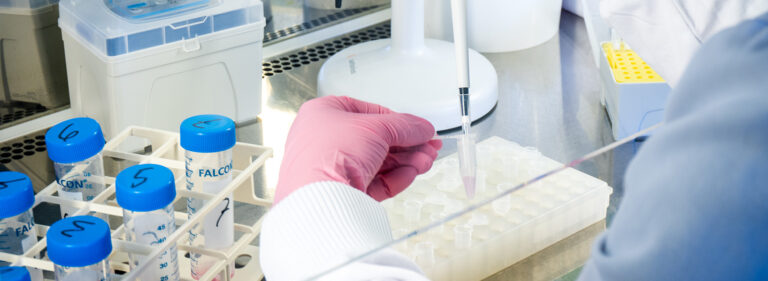Biobank material
A unique collection enables high-quality research. The Blood Service Biobank collects samples and data as part of blood donation from blood donors who have joined the Biobank.

Why choose us?
The Blood Service’s quality assurance system and our highly competent staff help ensure that our samples are of high quality. It is our aim to constantly improve our services.
Our samples are collected from people eligible to donate blood from all over Finland, and our collection is constantly growing. Our material includes longitudinal samples, special collections and genomic data.
Depending on the needs of your research project, we can carry out tailored sample collections or deliver material based on factors such as phenotype or genotype. We can deliver samples fresh or frozen. You can apply for material for research purposes based on desired criteria, such as specific health or demographic data. Our material is also well suited for use as reference material.
Off-the-shelf samples
From our sample collection we can select samples based, for example, on donor phenotype or genotype as appropriate. Time stamps for collection, processing and freezing are available for all samples. The samples are collected during blood donation from people who meet our blood donation criteria and have joined the Biobank.
Cord blood collection
Between 1999 and 2013, the Finnish Red Cross Blood Service collected cord blood for its Cord Blood Bank from consenting mothers who had just given birth. These samples were transferred to the Blood Service Biobank in 2023 after specific consent was obtained.
The cord blood products contain blood collected from the placenta following childbirth. During production, samples were taken from the cord blood units for possible further testing. Blood samples (plasma, serum and leukocytes) from the mother were also stored in the archives for possible further testing.
The samples are stored in a liquid nitrogen freezer at -180°C.
Stem cell products from cord blood
Stem cell product from cord blood, 170 pieces.
Sample from cord blood product (other than stem cell product): Plasma (native), Plasma (20% HES), Live cells (10% DMSO), DNA.
Archive samples (maternal): Plasma, Serum, Buffy Coat.
Data associated with the samples
Time stamp for cord blood product processing, blood group, cell counts, tissue type (including HLA A, B, C, DRB1), pregnancy medical records and small blood count.
Bone marrow mesenchymal stromal cells (BM-MSC)
Between 2012 and 2022, the Finnish Red Cross Blood Service has collected bone marrow samples from healthy adult consenting donors. These bone marrow (BM) samples have been used for culturing mesenchymal stromal cells (adult stem cells, abbreviated MSC) at the Advanced Cell Therapy Centre, which is a GMP facility of the Finnish Red Cross Blood Service. Cell products, defined as Advanced Therapy Medicinal products (ATMPs), made from the cultured cells have been used as an experimental treatment for patients suffering from severe, treatment-resistant graft-versus-host disease.
Some of these cell samples are still stored as archival samples in accordance with regulatory requirements for 30 years from the administration of the cells to the patient. However, some of the cell samples are excess and these extra samples have been transferred to the Blood Service Biobank after a specific consent was obtained in spring 2025.
BM-MSC are primarily from passage 2 (p. 2), containing a minimum of 1 x 106 cells/ml (10% DMSO). It is also possible to obtain cells from passage 1 or in other formats. There are cells cultured both in animal-free conditions (using human platelet lysate as supplement) and in conditions containing fetal bovine serum (FBS).
The samples are stored in a liquid nitrogen freezer at -180°C.
Data associated with the samples
Currently there are samples from 20 donors in the Biobank.
MSCs have been characterized extensively at p2 by their expression of specific cell surface markers consistent with the MSC phenotype and their ability to differentiate into osteogenic and adipogenic lineages. Also, CFU-F (colony forming unit-fibroblast) value is available, indicating the initial number of MSCs in the bone marrow sample when the culture was established. Furthermore, MSCs have been tested, e.g., to be immunosuppressive by T cell proliferation test and population doubling (PD) information is available from most of the samples.
Transferable information about the donors includes: 1) age at the time of donation, 2) gender, 3) tissue type (including HLA A, B, C, DRB1), 4) ABO-Rh blood group, 5) blood cell count in the bone marrow sample at the time of donation, and 6) cytomegalovirus (CMV) status at the time of donation.
Donors are always tested and found negative for infections according to the EU Blood Directive (2002/98/EC and 2004/33/EC) and national legislation (Blood Service Act and the Finnish Medicines Agency Fimea’s regulation 2/2023, Blood Service Operations).
Sample collection based on research project needs
We’re able to carry out tailored sample collections based on factors such as genotype or phenotype. We can also carry out sample collections in a certain area of Finland, within a certain age group or based on other desired criteria. We’re able to provide whole blood samples or blood parts, including fresh or frozen whole blood and buffy coat. We only collect samples from blood donors who have joined the Biobank.
Whole blood samples
Samples are collected as part of blood donation from people who meet our blood donation criteria. The samples are primarily collected into 4–10 ml EDTA tubes, but if necessary, can also be collected in other types of sampling tube (e.g. Lithium-Heparin, Cell-Free DNA BCT). The total sample volume from each person is max. 12 ml. The samples can be delivered fresh or frozen.
Buffy Coat
Samples are collected as part of blood donation from people who meet our blood donation criteria. The buffy coat is the leukocyte-thrombocyte fraction of centrifuged donated blood and also contains a small amount of plasma and erythrocytes. The samples are delivered the day after blood donation. The total volume of each Buffy Coat is approx. 55 ml.
Donors
Valid consent and acceptance to biobanking at the Biobank, consent to recalls (invitations to participate in a new study). The numbers are approximates, updated 6/2025.
| Information | Female | Male | All |
|---|---|---|---|
| Consent valid | 43 519 | 27 834 | 71 353 |
| Can be recalled | 41 288 | 26 274 | 67 562 |
Health related data
Health related data provided by donors on the Biobank’s supplementary information form since 2017 and the Biobank's Health Questionnaire Form (10/2024 onwards). The numbers are approximates, updated 06/2025.
| Data | Data available / donor | Additional information |
|---|---|---|
| Height | 68854 | Self reported |
| Weight | 68609 | Self reported |
| Smoking | 68946 | Self reported |
| Use of nicotine pruducts | 773 | Self reported |
| Alcohol consumption | 761 | Self reported |
Sample material
The samples have been collected as part of blood donation from people who meet the blood donation criteria. Time stamps for collection, processing and freezing are available for the samples. Longitudinal samples refer to a minimum of 2 samples from the same person collected at different time points. The numbers are approximates, updated 6/2025.
| Sample type | Donors | Longitudinal samples |
|---|---|---|
| DNA | 67 763 | na |
| Plasma | 8413 | 886 |
| Serum | 7450 | 323 |
| PBMC | 3603 | 268 |
Data available
The data available from our data sets includes information on donors and data from sample analyses. Donor information includes age, sex and place of residence. More specific data, such as genotype or immunogenetic data*, is available for some donors. Information concerning donors’ blood donation history, including blood group, haemoglobin, number of donations and eligibility for donation, is also available. Laboratory data from sample analysis is also available for researchers (see * below), and special analysis data returned to the Biobank by research projects is available for use in subsequent studies. The numbers are approximates, updated 6/2025.
| Data | Data available / donor | Additional information |
|---|---|---|
| Genotype* | 58000 | |
| Proteomics data* | 1000 | |
| Metabolomics data* | 1000 | |
| Immunogenetic data (classical HLA, KIR)* | 35400 | Imputed data |
| Immunogenetic data (non-classical HLA)* | 500 | Clinical grade data |
| Immunogenetic data (MICA/MICB)* | 800 | Clinical grade data |
| Clinical chemistry* | 2500 | |
| Complete blood count* | 3000 |
*HLA/ KIR
*Genotype
Genotype data was returned to the Biobank from the FinnGen project. The genotyping in the FinnGen project was performed on a FinnGen Thermo Fisher Axiom custom array at the Thermo Fisher genotyping service facility in San Diego. For more information, visit the pages of the FinnGen-project.
*Proteomics data
*Metabolomics data
*Clinical chemistry
- Basic chemistry: Serum alanine aminotransferase, serum lipids, serum glucose, serum sodium, serum potassium, serum creatinine, serum alkaline phosphatase, serum aspartate aminotransferase, serum calcium, serum protein, serum inorganic phosphorus, serum albumin.
*Complete blood count
- Complete blood count: haemoglobin (HGB), haematocrit (HCT), red blood cell count (RBC), mean corpuscular volume (MCV), mean corpuscular haemoglobin (MCH), platelets (PLT), fasting white blood cell count (WBC), white blood cell differential count, NEUT and NEUT%, EOS and EOS%, BASO and BASO%, MONO and MONO%, LYMPH and LYMPH%, red cell distribution width (RDW).


